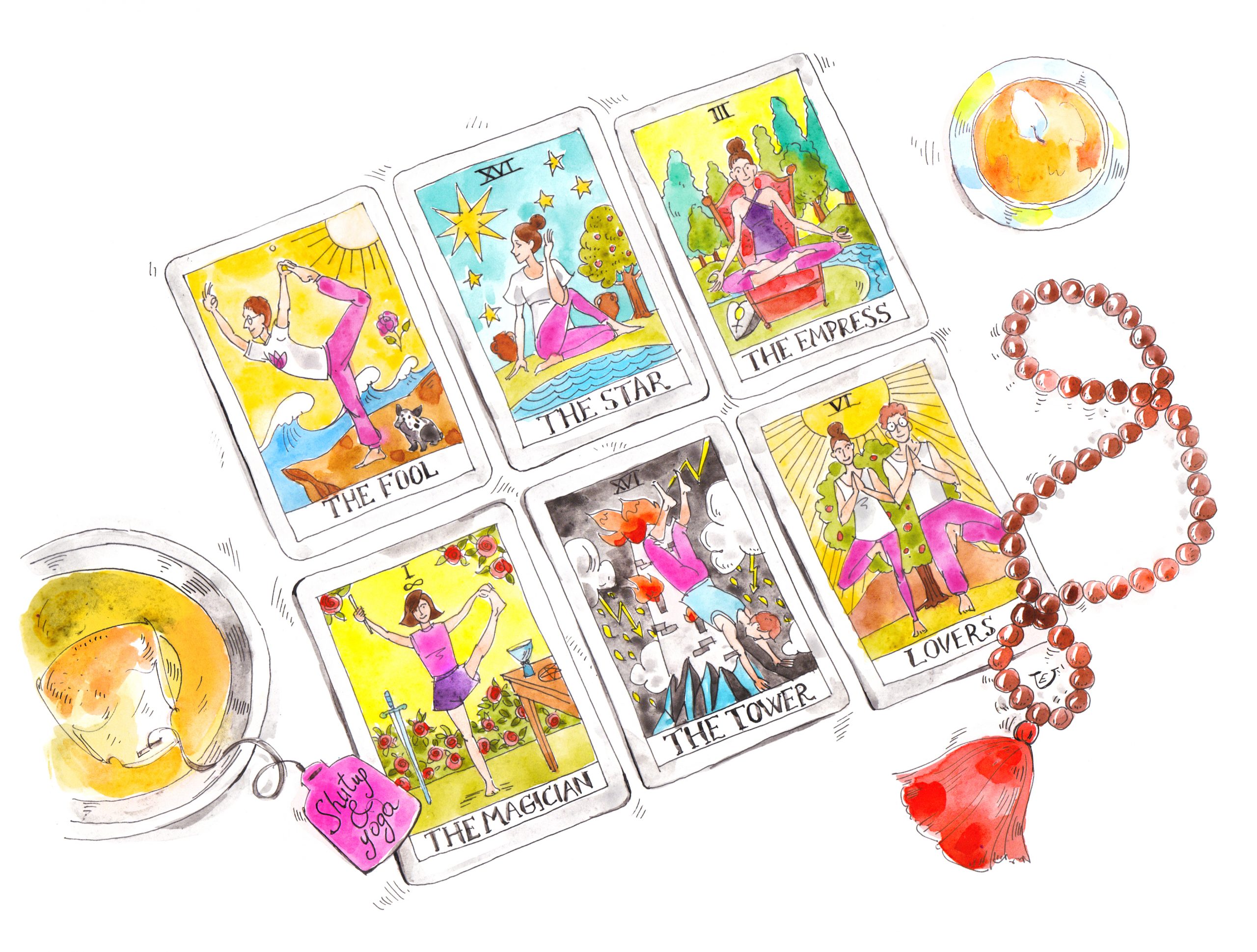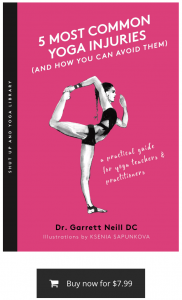The clock read 6:45 AM, but I had no desire to get out of bed. I wasn’t tired – I’m naturally an early riser, so my body and mind were awake – I just couldn’t face another lackluster meditation.
I’d been in the same routine for months. Here’s how it would go: I’d roll out of bed, drink some water, set my timer, and close my eyes for 10 or 15 minutes. I might recite a few mantras that I’ve used for years or maybe do a visualization. Once the little bell rang, signaling the time was up, I’d do a bit of journaling, then it was time to get ready for work.
Simply put, my meditation practice was getting stale. It felt like forever since I’d had any inkling of inspiration or insight after closing my eyes. Not like that happened every time – not at all – but even the sensation of feeling calmer and lighter had vanished. It felt like a chore and, folks, I was bored.

Cue guilt. How could I have let this beautifully ancient and exquisite practice become (gasp!) boring?!
I rushed to switch things up. Instead of meditating in the morning, I tried doing it before bed. This just made me extra sleepy, and I ended up cutting it short and just slipping under the covers. Next, I tried reciting a new mantra, but the words didn’t resonate and it felt forced. I even switched up my sitting position. After five minutes, my left leg got a wicked cramp, and I got so frustrated I gave up.
One day, for whatever reason – intuition, desperation, who knows – I grabbed my tarot deck and drew a card before meditating. I pulled The Star (on the photo below). It’s a beautiful card depicting a woman kneeling over a pool of water, two vessels containing water in her hands, the starry night sky above. I sat there, eyes closed, picturing it and how it made me feel. A sense of deep calm washed over me as I held this image in my mind, the card resting in my hands.
Suddenly, the bell sounded on my timer, and the 15 minutes were up. It seemed like no time had passed, and I felt lighter, more rejuvenated. It surprised me how quickly I was able to shake off the cobwebs by drawing a single card. How new and sparkly meditating suddenly felt.
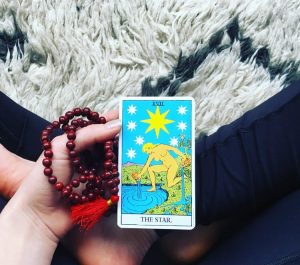
The magic behind tarot
I can’t remember exactly when I saw a tarot deck for the very first time. All I know is that the tarot always felt familiar to me. I believe the tarot was waiting patiently in the periphery of my awareness, and when the time was right, it slid into my consciousness. Like an actor waiting backstage for her cue, then stepping into the light, taking center stage. That’s kind of how the tarot emerged in my life.
It was winter, and I was visiting my sister in upstate New York. We were having coffee, the bright morning light beaming into her kitchen, when I spotted a tarot deck resting on her coffee table. I picked up the deck, its weight heavier than I expected, and shuffled through the cards. I was instantly mesmerized. The imagery was so detailed – each card told a story whose meanings I was eager to explore. My sister and I spent the whole morning pulling cards for each other, looking up their meanings over cups of steaming coffee, sharing what we thought each of them symbolized for us.
Ever since then, I’ve been hooked.
What is tarot, you ask?
If you’re new to tarot or don’t know what it is, here’s a (very) boiled down history:
Tarot cards likely originated in northern Italy during the 14th or 15th century and were originally used as playing cards, their popularity quickly spreading across Europe. At first, these cards were used to play a game called triumph, similar to a game of bridge. But over time, around the 1700s, they began to be used for divination purposes.
The 78-card deck includes four suits (Pentacles, Wands, Swords, and Cups) numbered 1-10 as well as court cards (Page, Knight, Queen, and King), otherwise known as the “Minor Arcana.” What differentiates a tarot deck from a traditional set of playing cards are an additional 21 “Major Arcana” cards made up of symbolic imagery and titles that evoke certain energy and invite interpretation. Cards like The Fool, The Magician, The Star, The World, and Death.
I like to think of the Minor Arcana symbolizing the nitty-gritty, day-to-day challenges and aspects of our lives, while the Major Arcana serves up the “big picture” messages that have a more archaic, intuitive meaning.
No, it’s not evil witchcraft
I’m here to halt any misconceptions you may have about the tarot: It’s not evil witchcraft, and it does not predict your future, nor does it tell you what to do in order to make x, y, or z happen. Apologies if I’m bursting anyone’s bubble, but you are still an autonomous human being with a free will.
Tarot is about exploring different aspects of yourself from a deep, intuitive place. It’s used as a tool for our soul’s growth and evolution. The cards can help provide insight on a challenging problem you’ve been ruminating over, uncover and heal difficult emotions you’ve been hanging onto, shed light on choices you need to make about your relationships, career, and so on. The tarot can help you understand yourself more deeply.
What makes tarot so potent is not that the cards harbor some mystical power or magic per se, it’s that they illuminate humankind’s most innate dilemmas and desires. That’s why we’re still using the tarot 600+ years after it originated, because humans continue to struggle with the same fundamental emotions and issues. We all want to love and be loved, to feel safe, to be heard. The tarot serves as a tool to tap into these core human emotions and needs.
If you’re curious at all about incorporating the tarot into your meditation practice, I’ve listed some pointers that might help.
Know your why
Introducing the tarot into a meditation practice can be for a variety of reasons. You may feel stuck in a “meditation rut” like I was. You may have a question you’ve been chewing on for a while and are seeking clarity. Or, you may just want to explore a deeper part of yourself. What’s so liberating about the practice is that it can help with all of these reasons and more. Whatever is drawing you to it, if it’s coming from a genuine place, then you’ll receive pretty incredible insight.
Cleanse your deck
Tarot cards are keepers of profound energy! If you’ve just bought your first deck – or dusted off an old deck that’s been laying at the bottom of a drawer – I recommend cleansing it, to rid it of any negative energy or stagnation. There are many ways to cleanse your deck – meditation, smudging, crystals, or simply shuffling the cards (be mindful not to bend them like you would a regular deck of playing cards). For more on how to cleanse your deck, scroll down to the bottom of this article.
Ask a Question, Pull a Card
When I’m meditating with the tarot, I like to first close my eyes and clear my mind for a moment. If I have a question I want to ask the tarot, I’ll ask it then. If no questions are coming up for me, I’ll ask the deck, what do I need to know today? Or, what energies or themes in my life need my attention right now?
Now comes the fun part. In tarot, there are several ways you can draw a card from the deck. You can shuffle the deck, cut it into three piles, then place them all back again, and draw from the top. You can fan them out in a half circle, and select a card that you feel most drawn to, or you can shuffle the cards and wait until one drops onto your lap. There are countless ways to draw a card, but this last method is my favorite. I feel like the cards are speaking their magic wisdom to me when I wait for a card to fall on its own!
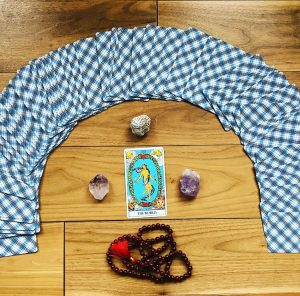
Tarot and intuition: Two peas in a pod
The wonderful thing about tarot is that you don’t have to have all 78 cards’ meanings memorized. It’s helpful to know the differences between the Major and Minor Arcana cards, but tarot is all about tapping into your intuition, a gift we were all born with!
If I feel stuck or don’t know what a card means, a helpful trick I’ve learned is to analyze what is literally going on in the card. What’s taking place in the picture? Is there any action among the figures in the card? What story is the card telling? This usually helps me get unstuck, so to speak, so that the card’s energy and its essence begin to take shape.
I’ve found that the more I combine tarot with meditation, the more in-tune and grounded I feel within my body.
And then, I sit, eyes closed, the pulled card resting in my palms, and what blossoms is usually quite revealing. I’ve found that the more I combine tarot with meditation, the more in-tune and grounded I feel within my body. In a more literal sense, the card gives me a focal point for when my mind wanders off to my never-ending to-do list or what I’m going to cook for dinner that day.
It’s also getting me closer to the tarot in a personal way. Where before, I’d rely on Google to tell me a card’s meaning, I’m now putting more stock in my intuition and what I feel the card is trying to tell me, in that moment.
Journaling after a tarot meditation is like unloading a big bag of groceries
Okay, not the greatest analogy, I admit, but for me, journaling is a chance to take any thoughts or inspirations that come up during my meditation and dump them onto the page. I can then organize my thoughts and try to make sense of what rose to the surface.
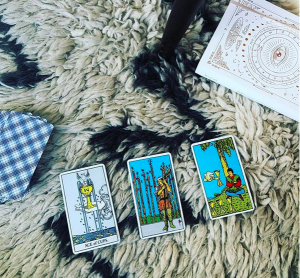
A bonus to all of this – other than exploring the winding paths of our minds, of course – is that after doing this a number of times, I now have a library of tarot card meanings that resonate with me on a deep level. Going back and reading these entries have also been quite illuminating.
Sometimes, stagnation is a good thing
As with many things, habits and routines need a bit of ‘spring cleaning’ every now and then. At first, I was disappointed that my meditation wasn’t giving me all the feels anymore, but it led me to the tarot which helped evolve it into something totally new and inspiring again. I’ve learned that sometimes we need a bit of stagnation to prompt us to open the windows and doors and let in new light, new air, new energy into our day-to-day lives.
I’ve learned that sometimes we need a bit of stagnation to prompt us to open the windows and doors and let in new light, new air, new energy into our day-to-day lives.
So when stagnation hits, remember to stay curious and let your intuition guide you. Switching up your routine can take a bit of trial and error, but with patience, you’ll land on something transformative.
Got questions about the tarot? Curious to learn more? Here are some general tarot tips for the newbies out there.
Any deck will do
If you don’t own a tarot deck, you can find them at any new age shop, bookstore, and online. Do a bit of browsing and select a deck that you feel personally drawn to. For beginners, the Rider-Waite tarot deck is certainly a great place to start. It’s by far the most well-known tarot deck, and its imagery and symbolism is a wonderful introduction to the tarot. More than anything though, select a deck that feels right to you.
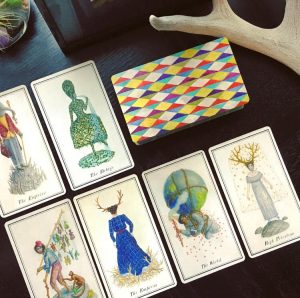
How to cleanse your deck
There are several different ways to cleanse your deck – here are a few:
Meditation – Take your tarot deck in your hands, and simply close your eyes and clear your mind. Envision your hands soaking up any energy that is “stuck.” Let the energy pass into your hands, through your body, and out the top of your head. Visualize this flow for as long as you like, or until you feel the cards are ready.
Smudging – You can also “smudge” your tarot cards, by burning some sage, palo santo wood, or even a candle, and passing your tarot cards through the smoke a few times.
Crystals – If you have any quartz crystals lying around, place the crystals on top of your tarot cards. Quartz is known for absorbing energies.
Shuffling – If none of the above suggestions work for you, shuffle your cards, reinvigorating them with your energy through your hands. Shuffle as many times as you like in whatever way you like (just try not to bend them like you would a deck of playing cards). After shuffling, I like to divide the deck into two halves, then gently knock or tap them together to release any energies that could be “stuck” inside.
Questions to ask the tarot
Tarot exists only in the present moment. When asking questions, keep them simple and open-ended so that the tarot can speak to you in ways that provide insight on the big themes and energies in your life. For example, you wouldn’t ask the tarot: Where and when will I meet my soulmate? Because as we all know, the tarot does not predict the future. Instead, reframe the question into something like this: How can I open myself up to love in my life?
Above all else, come to the tarot with an intention.
Coming up blank? Here are a few questions that can be a wonderful jumping off point:
- What am I being invited to pay attention to right now?
- Where am I on my journey of life right now?
- What energies are coming up for me in this present moment?
Additional Resources
There are literally thousands of resources on Tarot out there, so it can be quite overwhelming when trying to find helpful, legit tools and guides. Here are a few I’ve come to trust:
Holistic Tarot, by Benebell Wen – This book takes an integrative approach to reading tarot and helps you to tap into the tarot for personal growth. It’s great for both beginners and advanced readers and breaks down each card’s meaning. I recommend reading it with a pencil and underlining what resonates with you. There’s so much information in this book, so it’s helpful to highlight sections that you can easily come back to.
Biddy Tarot – This website is super helpful for learning the cards’ meanings as it interprets them in a way that’s relatable and easy to understand. Fantastic for beginners – there’s everything from tarot spreads to the difference between Major and Minor Arcana cards, and how to read for other people. Worth giving a follow on Insta: @biddytarot
Tarot for the Wild Soul Podcast – This weekly podcast, hosted by Lindsay Mack, takes an intuitive, soul-centric approach to reading Tarot. She welcomes inspiring guests, answers commonly asked tarot questions, and digs real deep on the card’s meanings and how they impact our lives. This podcast is seriously like dipping your finger into honey: profoundly nourishing and yummy! The podcast is on Instagram, too: @tarotforthewildsoul
Seventy-Eight Degrees of Wisdom: A Book of Tarot by Rachel Pollack – While I admit that I haven’t read this one yet, it’s next on my reading list! Others have described it as the holy grail of tarot books. So, apparently, it’s a must-read.
I get a lot of tarot inspiration while scrolling through Instagram, too. There are so many wonderful humans out there right now with such beautiful insight on the tarot. Definitely worth checking out. If nothing else, enjoy their gorgeous feeds: @wildsoulhealing, @the_numinous, @the_wild_unknown, @biddytarot, @boho_tarot, @themysticalarts, @soulfulowltarot, @madeleineillustration, & @bakaraw.
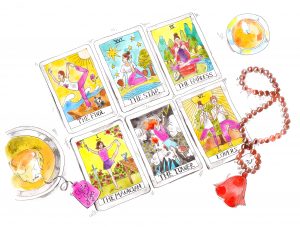
Illustration by Katya Uspenskaya
Photos by author
Edited by Ely Bakouche

